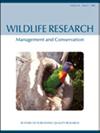发现阿坝蛇:影响一种濒危蛇利用改良洪泛区湿地的因素
IF 1.6
3区 生物学
Q3 ECOLOGY
引用次数: 0
摘要
本文章由计算机程序翻译,如有差异,请以英文原文为准。
Finding Ngabi (Hemiaspis damelii): factors affecting the use of modified floodplain wetlands by an endangered snake
ABSTRACT Context. River regulation, coupled with climate change, has caused significant declines in global freshwater biodiversity. In Australia, water extraction within the Murray–Darling Basin (MDB) has reduced the frequency, extent and duration with which floodplains are inundated, resulting in widespread declines in wetland-dependent biodiversity, including reptiles. The endangered Ngabi (Hemiaspis damelii) is associated with floodplain systems in the MDB, yet its distribution and ecological requirements are poorly understood, hampering conservation actions. Aims. We sought to validate an assumption that Ngabi is associated with wetland vegetation communities before investigating factors affecting its probability of detection in the lower Murrumbidgee catchment in southern New South Wales. We predicted Ngabi occurrence patterns would relate to frog abundance, wetland hydrology, microhabitat attributes and meteorological variables. Methods. We compared Ngabi observations from 16 paired wetland and dryland vegetation transects to evaluate associations with vegetation type. We then used generalised linear mixed models to relate snake presence and absence to prey (frog abundance), microhabitat (logs and ground cover), wetland hydrology (water depth and inundation frequency) and meteorological conditions, using 12 repeat surveys between September 2018 and March 2021. Key results. Fifty-eight snakes were observed at five of eight wetlands during the study. Ngabi was exclusively recorded in river red gum/spike rush or lignum vegetation communities, and was absent from sandhill woodland or chenopod communities. The probability of detecting Ngabi increased with ambient temperature and weakly with wetland inundation frequency, but not frog abundance, microhabitat attributes or year. Conclusions. Ngabi is strongly associated with floodplain vegetation communities and, to some extent, frequently inundated wetlands in southern NSW, suggesting water management agencies should incorporate threatened floodplain snake species into future wetland management plans. The use of environmental water to restore aspects of flow regimes, improve wetland health and aquatic diversity is likely to benefit other wetland-dependent snake populations across the MDB. Implications. The positive relationship between Ngabi detections and ambient temperature will be important for designing an effective monitoring program for the species across the MDB. Furthermore, our findings provide insight into the benefits of using environmental water to create wetland refuges to maintain floodplain snake populations during droughts.
求助全文
通过发布文献求助,成功后即可免费获取论文全文。
去求助
来源期刊

Wildlife Research
生物-动物学
CiteScore
4.30
自引率
15.80%
发文量
56
审稿时长
3 months
期刊介绍:
Wildlife Research represents an international forum for the publication of research and debate on the ecology, management and conservation of wild animals in natural and modified habitats. The journal combines basic research in wildlife ecology with advances in science-based management practice. Subject areas include: applied ecology; conservation biology; ecosystem management; management of over-abundant, pest and invasive species; global change and wildlife management; diseases and their impacts on wildlife populations; human dimensions of management and conservation; assessing management outcomes; and the implications of wildlife research for policy development. Readers can expect a range of papers covering well-structured field studies, manipulative experiments, and analytical and modelling studies. All articles aim to improve the practice of wildlife management and contribute conceptual advances to our knowledge and understanding of wildlife ecology.
Wildlife Research is a vital resource for wildlife scientists, students and managers, applied ecologists, conservation biologists, environmental consultants and NGOs and government policy advisors.
Wildlife Research is published with the endorsement of the Commonwealth Scientific and Industrial Research Organisation (CSIRO) and the Australian Academy of Science.
 求助内容:
求助内容: 应助结果提醒方式:
应助结果提醒方式:


